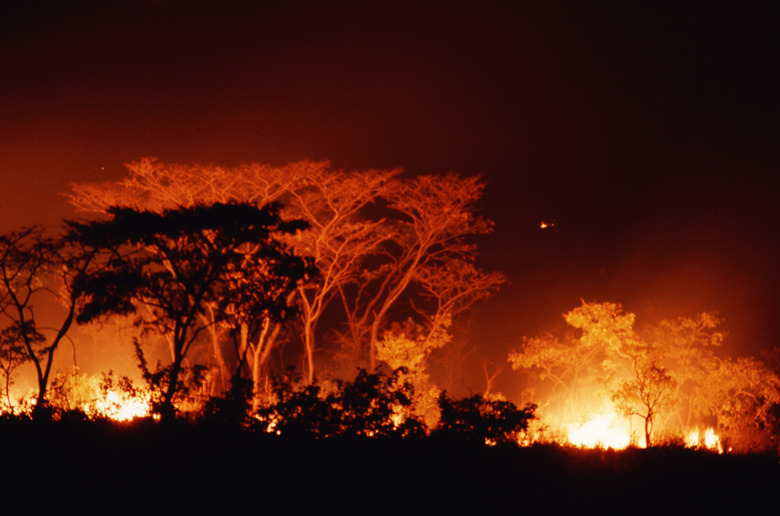How Fast Can Forest Fires Spread?
Wildfires – also called bushfires or forest fires – are among the foremost ecological disturbances on Earth. Whether sparked by lightning, lava flow, human carelessness or other triggers, these blazes can be catastrophic for people in their path, but they also help to shape and maintain certain ecosystems such as savannas, prairies and shrublands. Under the right circumstances, a wildland inferno can spread with terrifying speed.
TL;DR (Too Long; Didn't Read)
Under the right circumstances, a forest fire can spread with terrifying speed. A fire's forward rate of spread naturally depends on many factors, particularly wind and other weather conditions, fuel type and condition, and terrain. It's difficult for a human observer on the ground to accurately estimate the speed of an encroaching wildfire, and in forests, people tend to overestimate the distance of a fire from themselves, which can be a fatal error. Factors such as wind speed, type of fuel and terrain can influence a forest fire's spread rate. Maximum speeds for wildfires are estimated to be approximately ten miles per hour.
Maximum Speed
Maximum Speed
A wildfire's speed is often judged as its forward rate of spread, which describes the pace at which its leading edge advances perpendicular to the fire front. The authors of the book "Grassfires: Fuel, Weather and Fire Behaviour" indicate that the general maximum speed of between 16 and 20 kilometers per hour (9 to 12.5 mph) for wildfires. A fire's forward rate of spread naturally depends on many factors, particularly wind and other weather conditions, fuel type and condition, and terrain.
Illusions
Illusions
It's difficult for a human observer on the ground to accurately estimate the speed of an encroaching wildfire. People might overestimate the rate of a conflagration's advance because of the dramatic whipping of flames by heavy gusts or the convoluted routes an observing motorist must take in comparison to a fire's straight-line march. It's just as easy to underestimate. After all, as Australia's Bushfire Cooperative Research Centre notes, humans tend to judge the speed of an object by the change in size of its image in our retinas. This works better for an object of stable shape; the constant, erratic shifting of a fire front's image throws off human gauging abilities. Some evidence suggests that in forests and woodlands humans tend to overestimate the distance between themselves and a fire – which can be a fatal miscalculation.
Wind and Terrain
Wind and Terrain
A strong wind speeds a burn's advance not only by tossing firebrands well ahead of the main fire front and by supplying it fresh oxygen but also by tilting flames forward and thereby drying and "preheating" vegetation in their path, making it susceptible to combustion more quickly. Similarly, a blaze may spread faster on a steep slope than a level plain because on the former flames can preheat uphill fuel. Valley winds – movements of air up an incline due to differential heating during the day – can dramatically affect fires via the "chimney effect," which is when breezes sucked in a ravine or canyon mouth can quickly fan flames up its entire course. Other kinds of regular terrain-influenced air movements, such as slope and land and sea breezes, can also hasten or dampen fire fronts.
Other Influences
Other Influences
The moisture content of an area's vegetation impacts the speed of a wildfire: Drier grasses, shrubs and trees burn more readily. The type of vegetation community also matters. A tract of dense conifer forest or tangled chaparral will often provoke a bigger, faster-moving fire than sparse grassland or airy savanna. A particularly large and intense wildfire creates its own local weather, which can bolster its speed: Convection over such a conflagration can suck in winds or form pyrocumulus clouds with their violent turbulence and potential lightning, all of which may rapidly spread flames or spark new subsidiary burns.
Cite This Article
MLA
Shaw, Ethan. "How Fast Can Forest Fires Spread?" sciencing.com, https://www.sciencing.com/fast-can-forest-fires-spread-23730/. 24 April 2018.
APA
Shaw, Ethan. (2018, April 24). How Fast Can Forest Fires Spread?. sciencing.com. Retrieved from https://www.sciencing.com/fast-can-forest-fires-spread-23730/
Chicago
Shaw, Ethan. How Fast Can Forest Fires Spread? last modified March 24, 2022. https://www.sciencing.com/fast-can-forest-fires-spread-23730/
